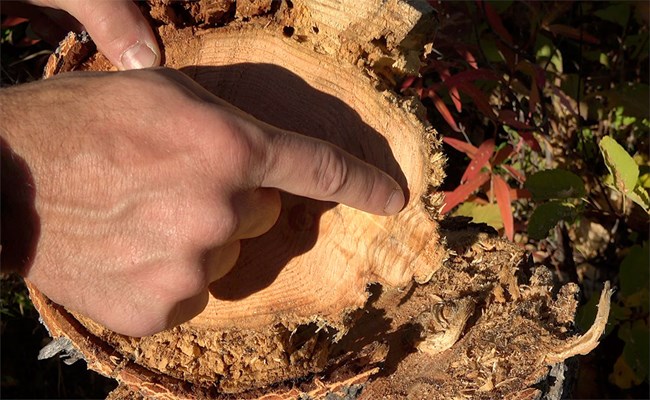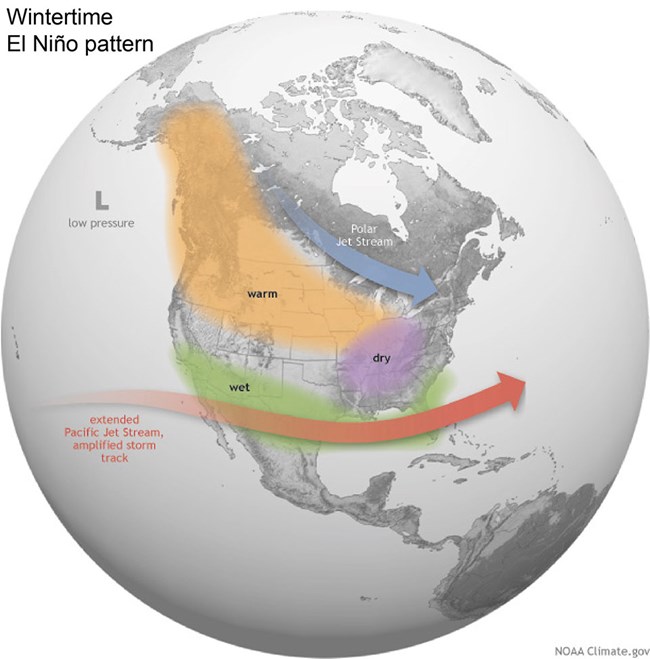By Peri Sasnett
Article
Glacier's Avalanche Cycles: Past, Present, and Future

NPS
Ishove another massive shrub out of my way, hoping to find a clear path before me. No such luck. Instead, I see a never-ending swath of head-high alder bushes. I devise a strategy. Carefully balancing on top of a downed log, I begin to follow it. To my relief, several others lie ahead, creating a clearing through the thick vegetation. But eventually those run out, and I’m stuck swimming through the dense brush once again. According to the GPS unit, we’re only half a mile from the Going-to-the-Sun Road, but from what I can see, we could be anywhere.
Leading the way is Erich Peitzsch, a U.S. Geological Survey (USGS) physical scientist who’s chosen this fall day to collect data, hopeful he won’t disturb too many visitors with the roar of his chainsaw. Ironically, we’re out in the warmth of the September sun to study avalanches, without a snowflake in sight.
Peitzsch is part of the USGS Climate Change in Mountain Ecosystems program, based in Glacier National Park. Small but widely known, the group studies the park’s melting glaciers and other ice features, and monitors climate change impacts in the alpine. Peitzsch’s research specifically focuses on understanding how climate change will affect avalanche cycles in Glacier and the surrounding area—and in turn, how those effects will ripple through the landscape beneath the snow.
While many of us may think of avalanches as a hazard for backcountry skiers or snowmobilers, they’re actually an important ecological phenomena. Much like wildfire, landslides, or beetle infestations, avalanches are a periodic landscape disturbance essential for wildlife habitat. Avalanches stimulate new growth, are a haven for nutrient-rich plants and berries, and create a patchwork of much-needed open space. Peitzsch and his collaborators are asking a fundamental question about these habitats and the avalanches that create them: will a changing climate affect avalanche behavior, and if so, how? His first step in answering these questions is to establish a timeline, or chronology, of past avalanche activity, providing a baseline from which to monitor future changes. This is where the chainsaw comes in.

While avalanches can easily snap mature trees, many trees survive a slide with only scarring on their trunks. These scars are recorded in the tree’s rings in the same way a drought year results in a narrow growth ring, or a fire leaves a charred area. “Reaction wood” is another pattern that can form within a tree’s rings in response to an avalanche. If a slide bends a tree downhill, it will grow asymmetrically to right itself, leaving a lopsided pattern in its otherwise-circular rings. An approved research permit allows Peitzsch to use a chainsaw to take slices, known as “cookies”, of dead and downed trees found in avalanche paths throughout Glacier and the surrounding area. He uses these cookies to date the trees and the years the scarring took place, allowing him to construct a record of major avalanche cycles over the past 100–200 years.
Peitzsch uses this record to tease out correlations between avalanche years and long-term climate patterns, called teleconnections. One well-known example is the El Niño/La Niña cycle (the El Niño/Southern Oscillation, or ENSO); others include the Pacific Decadal Oscillation (PDO) and the Arctic Oscillation (AO). These teleconnections have an effect—albeit not a simple one—on the variables of a winter here in northwest Montana, including temperature, precipitation, and storminess.

Many of Glacier’s large-magnitude avalanche cycles are brought on by a specific weather pattern. First, an extended cold snap with clear nights causes feathery snow crystals, known as surface hoar, to form on the snow’s surface. Once buried, these crystals serve as a lurking weak layer, with the potential to cause future avalanches. Next, a storm system arriving from the Pacific Ocean drops feet of snow on top of this existing weak layer, triggering major avalanches. Scientists are still studying exactly how climate change will affect these broader climate patterns (teleconnections), but any variations are likely to affect local weather patterns and thus avalanche behavior. For example, a shifting Arctic Oscillation that results in fewer cold snaps would mean a lower chance of surface-hoar formation (and associated weak layers), perhaps decreasing the number of slides we see. Conversely, changes in the PDO might make the Pacific storms stronger or more numerous, increasing the potential for major avalanches. These connections are incredibly complicated, and their effects on snowpack are not straightforward. As Peitzsch explains, “That’s where it gets complex…the interaction of fewer cold spells and warmer storms. Will we see more avalanches or will we actually see less avalanche activity? That’s what we’re trying to figure out now.” The multifaceted nature of these questions underscores the importance of Peitzsch’s work to understand them.
***

NPS/Peri Sasnett
The chainsaw whirs through the last tree of the day, and I breathe a sigh of relief. After helping lug forty samples out of the woods—some over three feet in diameter and weighing up to twenty pounds—I’m ready for a reprieve. Peitzsch needs this large sample size to get a clear picture of the past, because a single tree may not record each major avalanche that occurred in a given path. With the addition of samples from a dozen other local slide paths, his dataset now totals over 600 cross-sections and cores. Identifying and dating the avalanche scars within each one will be painstaking work, but it will illuminate the avalanche history of northwest Montana.
As we clamber up the last few feet to the road, and I pull the remaining alder twigs from my hair, I realize I’d never previously thought about avalanches in relation to climate change. Here in Glacier, we often highlight melting glaciers and wildlife impacts—the plight of the pika comes to mind. But I hadn’t recognized that something as seemingly unrelated to climate as avalanches could be affected as well. Nor did I know how important they are as wildlife habitat. The open canopy of an avalanche path provides abundant light and water—supporting huckleberries, cow parsnip, and glacier lilies, which are key food sources for grizzly and black bears. In the upper reaches of these meadows, bighorn sheep graze on young plants, while the open landscape allows them to watch for predators. In some cases, these treeless areas can also act as a firebreak, interrupting otherwise continuous acres of forest.
Given the diverse functions these habitats serve, it’s critical that we piece together how they may change going forward. This research is just one part of a holistic understanding of how climate change will impact Glacier National Park, beyond simply warmer temperatures or receding glaciers. Peitzsch, and his 600 cookies and cores, will provide a glimpse into the past, helping us understand the present and giving insight into what the future may look like.
Avalanches on the Going-to-the-Sun Road Story Map
Downloadable pdf
2017 Science in the Crown Newsletter
Last updated: October 14, 2024
